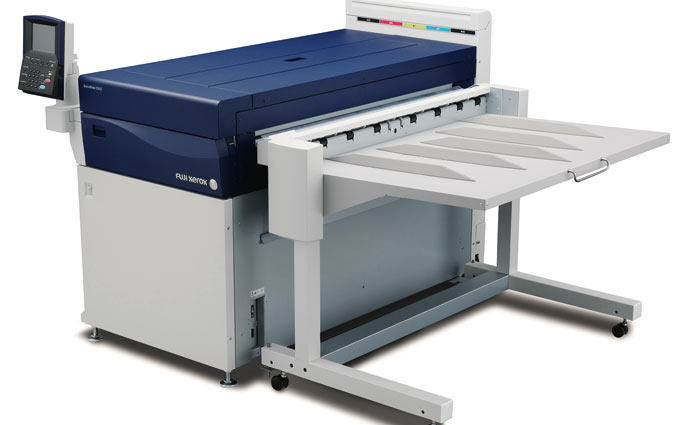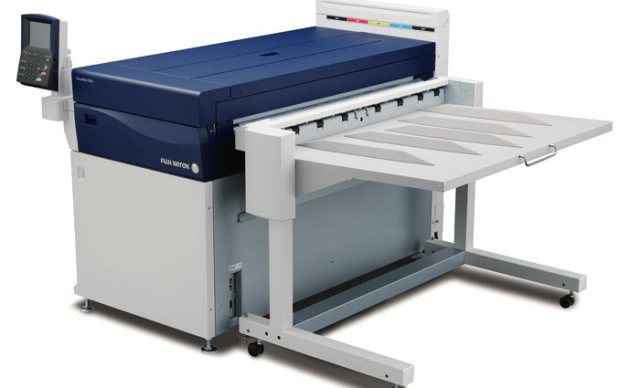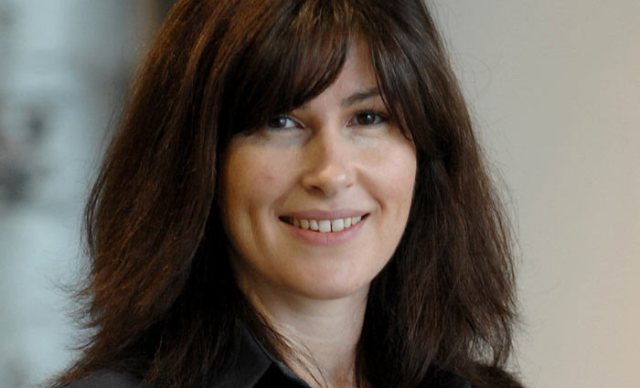
Back in May at PacPrint, Fuji Xerox took the covers off its new wide-format machine, the DocuWide C842, its first home-grown colour machine in the sector in a long time. Australian printers are among the first in the region – along with New Zealand and China – to be able to buy one.
The technology got a positive reaction at the show. Fuji Xerox national business manager, wide-format, Peter Collings said he was “very pleased with the way the launch went”.
That official launch came a year after the project first saw the light of day at Drupa, where a machine was tucked away on RIP partner Caldera’s stand. As is often the case with Drupa demonstrations, the rationale for its appearance was to get feedback about the concept. The feedback was positive and hence the C842 has now come out of hiding.
Fuji Xerox is no stranger to wide-format colour. In Australia, it has relationships with Epson and Mutoh to supply aqueous and eco-solvent machines, while it has an established position in black-and-white laser printers for CAD (computer aided design), AEC (architectural, engineering and construction) and GIS (geographic imaging systems) – aka maps.
“The C842 bridges the gap between our markets for CAD, GIS and graphics,” says Collings. “It complements monochrome laser and colour inkjet.”
Applications
The biggest graphics market for the C842 is indoor graphics, while it fits the requirement for higher-speed colour throughput for AEC, CAD and GIS. Collings says longer runs have been a productivity problem for these companies.
“Inkjet for interior posters and point of sale has been slow and high cost,” he argues. “As a result, digital printers have struggled when volumes get into the hundreds. It creates a real problem.”
Typically, a firm will end up adding shifts and maybe lifting other jobs to be able to get through a big run if they produce it in-house, or they will outsource it.
“All of this can throw the business into chaos and add extra costs,” adds Collings.
The C842’s throughput has other benefits, and the machine opens up new opportunities as well as solving current headaches. Collings reports that one user has shifted litho work to digital to reduce errors and costs in the pick-and-pack process for making up store kits. Rather than relying on an operator to collate store packs from pallets of static print, the customer now prints store kits as collated sets, eliminating the time taken to collate the sets and slashing errors.
While that improves a current process, Collings also sees an opportunity to marry Fuji Xerox’s variable-data expertise in small format with wide-format to introduce targeted messaging using products such as XMPie. He argues that while there have been attempts to use VDP in wide-format, it is only the throughput of the C842 combined with tools like XMPie that makes it really practical.
Performance
Linear printing speed is 152.4mm per second (or six inches in imperial) which means, when combined with the width of 1,067mm (42 inches), it comes out at 585.4sqm per hour. Fuji Xerox is more realistic in quoting achievable production speeds. The reasons for a slower practical than theoretical speed include cleaning cycles between each print in addition to time taken to stop and start between jobs and for operations such as cutting.
A realistic figure in the factory is 320sqm per hour, although the specs claim up to 420sqm per hour. In terms of sheets on the stack tray, it will churn out seven A0 per minute, or nine or 12 A1, depending on whether it is printing in landscape or portrait.
Even at Xerox’s realistic speeds, it’s no slouch, working out at roughly 10 times faster than the latest crop of eco-solvent machines. That sort of throughput requires equally powerful file processing. There are three options: a basic Windows print driver; a driver for Xerox’s Freeflow Access workflow, which is aimed at CAD, AEC and GIS networks; and a version of Caldera’s Grand RIP+.
Print-for-pay environments and any site producing anything more graphic and colourful than simple CAD line drawings will need the processing power of the Caldera RIP to keep up with the C842’s potential.
Substrates
Fuji Xerox sells a range of wide-format media especially for the C842 under the Accelerator brand.
Collings says users benefit from buying approved media as Fuji Xerox has tested the materials to ensure they work – adding that the inks are quite sensitive to the coating used – and also provides colour profiles. To date the range includes uncoated bond paper in three weights, 80, 100 and 115gsm, a coated matt in 100, 120 and 140gsm, a recycled coated matt in 125gsm, photo paper in gloss and satin finishes, and a polypropylene.
The firm is also testing additional materials to add to their range, including backlit, Tyvek, removable window graphic film, fabrics as well as a self-adhesive vinyl.
Media handling
The C842 is available with either one or two media drawers, each of which holds two rolls of media, allowing for a total of four rolls online. Drawers support two- and three-inch cores covering standard stocks for both laser and inkjet materials. It is possible to manually feed cut sheets, too. For banner applications, a print length of up to 5m is supported with reels and 2m pre-cut sheets.
Technology
At the heart of the machine, and essential for the combination of speed, quality and cost, is a single-pass, dye-based aqueous inkjet system. Single-pass means the heads are all fixed and just the paper moves, rather than the more usual shuttling carriage of printheads. That is what accounts for the speed but it also costs more money to put that much printhead firepower across the width of the machine.
The printheads themselves are of a relatively affordable type. They’re based on thermal actuation, like most desktop and aqueous wide-format machines, but built using MEMS (micro-electronic mechanical systems) techniques to keep the costs down.
Like most thermal heads, the C842’s heads are a consumable and so need replacing every few litres of ink and thousand metres of print. They are a user-replaceable component, and the cost is accounted for in the operating costs.
Quality
Resolution is 1,600×1,600dpi with some truly tiny droplet sizes, which translates into fine lines and crisp text for the CAD, GIS and AEC applications and smooth photo-realistic output for graphics applications. Unlike other Memjet-based machines, Fuji Xerox has stuck to the maximum resolution rather than offering even faster print at a reduced 800dpi.
Alternatives
While there are other single-pass, dye-based aqueous ink wide-format printers with very similar core technology, none has made it to Australia. So in the meantime, if you want fast, low-cost indoor graphics, mostly on paper, then the choices are the KIP C7800, as sold by Konica Minolta, and the Canon Océ ColorWave 600/650.
If you can wait, then more Memjet technology-based machines should be available soon. Canon used the recent Fespa 2013 in London to launch the Océ ColorWave 900, which is what the Project Velocity technical demonstration at Drupa 2012 became. This model uses the faster but lower-resolution setting of the Memjet heads for higher maximum throughput. It also has six paper drawers, each capable of handling two rolls, offering a wider range of onboard stock or longer unattended operation.
Then there is the RTI Vortex 4200, and RTI is looking for an Australian dealer. It has less onboard media handling but in countries where it is already sold is the most competitively priced Memjet-based machine.
Conclusion
With the DocuWide 842W, Fuji Xerox Australia has pulled a rabbit out of the hat. In Australia, the company is first to market with a compelling product that fulfills a previously unmet need in the wide-format market for high speed, high-quality indoor graphics and a competitive cost per metre.
Specifications
Applications Indoor posters and POS, CAD, GIS and AEC plots
Substrates Uncoated bond paper, inkjet coated matt, satin and gloss, polypropylene
Speed 320sqm/hr, 7 A0/min, 9 or 12 A1/min
Colours CMYK
Resolution 1,600dpi
Printing technology Single-pass thermal inkjet
Ink type Aqueous
RIP Caldera Grand RIP+
Contact www.fujixerox.com.au, 1300 231 688
The alternatives
Canon Océ ColorWave 650
The ColorWave uses Océ’s CrystalPoint technology, which combines aspects of toner and inkjet together. Spheres of toner pearls, which are solid at room temperature are melted and then applied to the paper using piezo inkjet. Not as fast as the C842, but more affordable, too.
Speed 210 A1/hr, 120 A0/hr
Colours CMYK
Resolution 600dpi
Printing Technology Océ CrystalPoint
Ink type hybrid inkjet/toner
Contact Canon, www.canon.com.au, 1800 444 199
KIP C7800
KIP has ploughed a lonely furrow, where others have abandoned toner in wide-format when switching to colour it has a unique proposition, albeit one that hasn’t completely captured the market’s imagination. It’s fast, it’s operating costs are acceptable but toner limits the range of substrates and finishes.
Speed 325sqm/hr
Colours CMYK
Resolution 600dpi
Printing technology toner
Ink type dry toner
Contact Konica Minolta, www.konicaminolta.com.au, 1300 789 389
Comment below to have your say on this story.
If you have a news story or tip-off, get in touch at editorial@sprinter.com.au.
Sign up to the Sprinter newsletter


